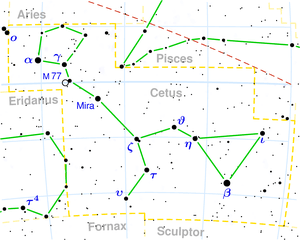|
|
Cetus ( latinized form of Ancient Greek κῆτος - kētos, “whale, any sea-monster or huge fish”) is a constellation of the northern winter sky, in the region known as the Water, near other watery constellations like Aquarius, Pisces, and Eridanus. Notable features This constellation's star is Mira (or ό Ceti), the first variable star to be discovered. Over a period of 331.65 days it can reach a maximum magnitude as high as 2.0m, one of the brightest in the sky and easily visible to the unaided eye, then drop to 10.1m and back again. Its discovery in 1596 by David Fabricius further dented the supposed unchangeability of the heavens and lent support to the Copernican revolution. Other stars in the constellation include α Ceti (Menkar); β Ceti (Deneb Kaitos), brightest in the constellation; and τ Ceti, the 17th closest star to Earth. The ecliptic passes close to the constellation boundary of Cetus, and thus the planets may be in this constellation for brief periods of time. This is even more true of asteroids, whose orbits usually have a greater inclination to the ecliptic than planets. The asteroid 4 Vesta was discovered in this constellation in 1807. Notable deep sky objects Cetus lies far from the galactic plane, so many distant galaxies are visible, unobscured by dust from the Milky Way. Of these, the brightest is Messier 77 (NGC 1068), a 9th magnitude spiral galaxy near δ Ceti. History This constellation has been known since antiquity. In Mesopotamia, it was identified with the primordial cosmic female principle, the sea-monster Tiamat. In Ancient Greece, together with the constellations above it, (Andromeda, Cepheus, Perseus, Cassiopeia, and possibly Pegasus), this may be the source of the myth of the Boast of Cassiopeia, with which it is usually identified. In certain earlier Greek legends, it also represented the gates (and gateposts) of the underworld (considered to be the area under the ecliptic). As such, together with other features in the Zodiac sign of Pisces (including Pisces itself, as well as prominent stars behind Cetus), it may have formed the basis of the myth of the capture of Cerberus in The Twelve Labours of Herakles. According to the Arabs, one of the hands of the Pleiades (Al-Thurayya) extended into part of the constellation Cetus. The Arabs also saw two pearl necklaces among the stars of Cetus. One pearl necklace was fully tied together and undamaged, but the other pearl necklace was broken and its pearls were scattered. Another generation of Arabs, like the ancient Hebrews and Greeks, portrayed an enormous Leviathan-like sea creature among the stars of Cetus. Namesakes In an episode of Gene Roddenberry's Andromeda, a giant, planet-consuming space creature is referred to as "The Cetus". References * Ian Ridpath and Wil Tirion (2007). Stars and Planets Guide Links
Retrieved from "http://en.wikipedia.org/"
|
|
|||||||||||||||||||||||||||||||||||||||||||

